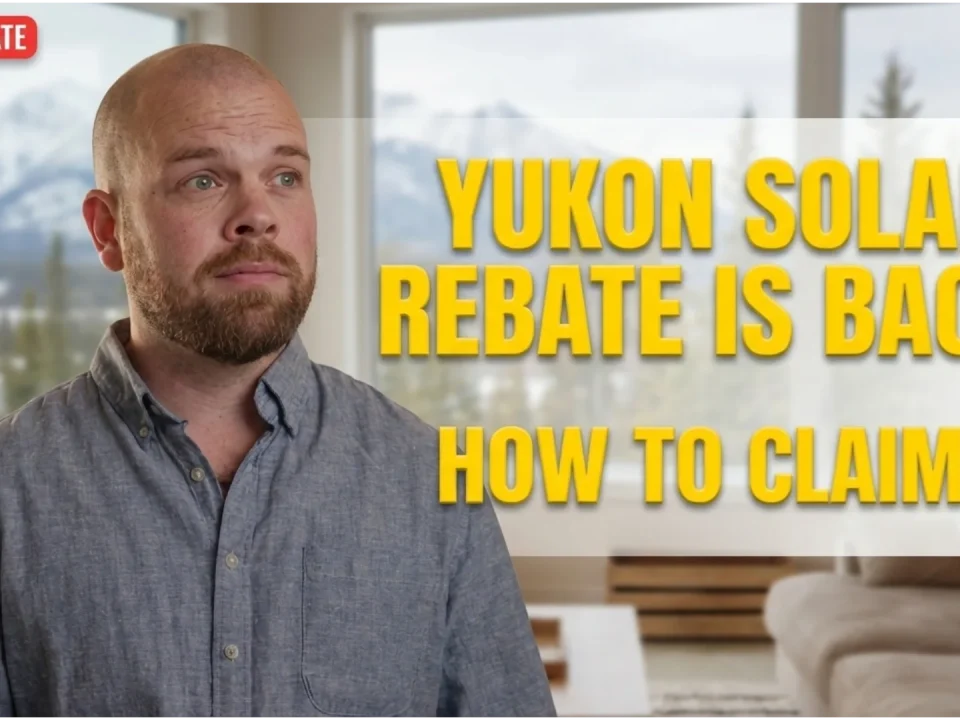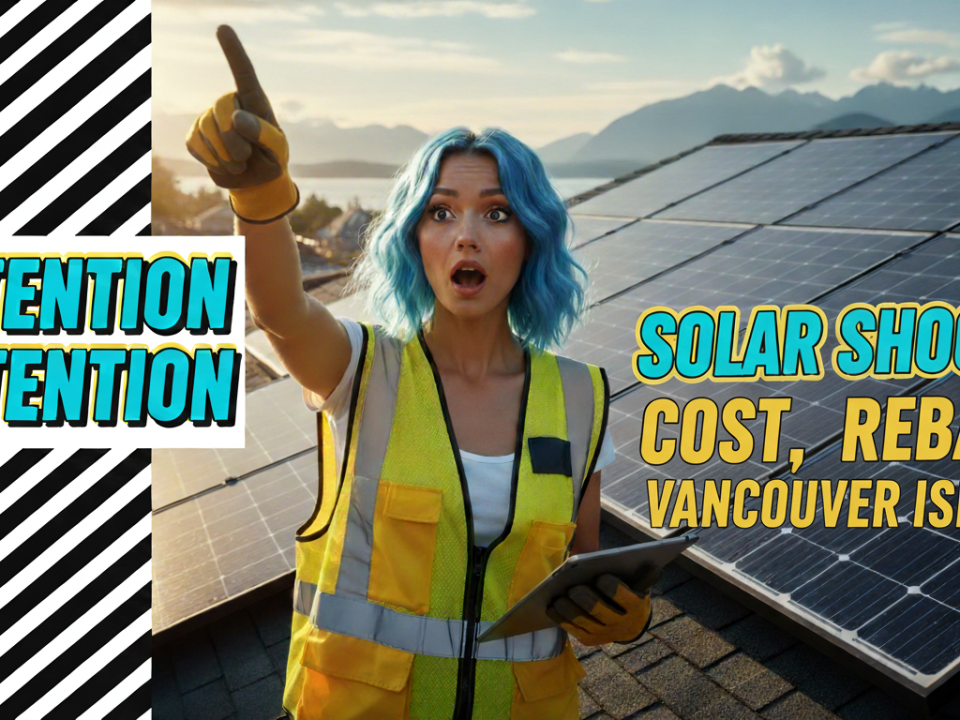
Solar Panels Northwest Territories Guide 2025
August 6, 2025
Solar Panels Alberta Guide 2025 + Calculator
August 7, 2025Today, we’re talking about the Yukon. And let’s be blunt: going solar in the Yukon right now is a tough call, and anyone who tells you otherwise isn’t giving you the full picture. There’s a lot of interest, and the government has big goals for renewable energy, but there are some serious roadblocks you need to know about before you even think about making an investment. This guide will walk you through the good, the bad, and what you can realistically expect from solar power in the Yukon for 2025.

The Main Hurdle: Why the Yukon’s Solar Program is on Pause
Let’s get right to the most important point. As of late 2023, and extending until at least January 15, 2026, the Yukon government has paused new applications to its Micro-generation Program for all communities connected to the main power grid.
You might be asking, what does that mean? Simply put, this program was the golden ticket for solar owners. It was the system that let you sell your extra solar power back to the grid for a credit on your bill. This is also known as net metering. Without it, the financial case for installing solar panels on your home changes dramatically.
The reason for the pause is that the Yukon’s grid has hit its limit for handling intermittent energy sources like solar. Too much power flowing back from homes and businesses without major system upgrades can cause instability and even power outages. So, while the interest in solar is high, the infrastructure needs to catch up. This pause has effectively put the residential solar industry on hold, which is why understanding the alternatives is now more important than ever.

Why is Solar Energy Important for Yukon?
Even with the current pause, solar power is critical for the Yukon’s future. The territory relies heavily on diesel fuel, especially in remote communities and during peak winter demand. This is expensive, bad for the environment, and leaves the territory vulnerable to fuel price changes.
Solar energy offers a path to greater energy independence. By generating power locally, the Yukon can reduce its reliance on imported fossil fuels. We’re already seeing this happen with larger projects. For example, the Sādę Solar Initiative in Watson Lake is a major Indigenous-led project that will build a 2.85 MW solar plant and battery system. It’s expected to cut diesel use in the community by over 1 million litres a year. This is where the real progress is happening right now—in large-scale projects that help the entire grid.
For the average person, the importance is about long-term stability. Electricity rates are not going down. As the Yukon invests in a cleaner grid, solar will become an even more valuable way for residents to control their own energy costs.

How Can Solar Panels Benefit Residents in 2025?
With the net metering program on pause, how can you possibly benefit from solar panels? The key is to shift your thinking from selling power back to the grid to using the power yourself. This is called self-consumption.
If you install a solar system, you can still generate electricity during the long summer days to power your home directly. This reduces the amount of electricity you need to buy from the utility, which will lower your electrical bill. The savings are not as great as they would be with net metering, but they are still there.
For those living in remote areas not connected to the main grid, solar is a game-changer. An off-grid solar system with battery storage can provide reliable power where there was none before, or replace a noisy, expensive diesel generator. It offers true energy independence.

Understanding Solar Panel Technology
Not all solar panels are created equal, especially when you’re dealing with the unique conditions of the north.
What Are the Latest Advances in Solar Panel Technology?
The solar industry is moving fast. A few years ago, standard panels were the norm. Now, new technologies are making panels more efficient and durable.
- PERC (Passivated Emitter and Rear Cell): This is a technology that adds a layer to the back of solar cells to capture more sunlight. It’s become a standard feature in most modern monocrystalline panels and offers a good boost in efficiency.
- Bifacial Panels: These are a fantastic option for the Yukon. Bifacial panels can capture sunlight on both sides. In the winter, when snow is on the ground, the light reflects off the snow and hits the back of the panel, generating extra power. This is known as the albedo effect.
- Tandem and Perovskite Cells: This is the next frontier. Scientists are layering different materials (like perovskite on top of silicon) to create “tandem” solar cells that can capture a wider spectrum of light. While still mostly in development, this technology promises huge leaps in efficiency in the coming years.
How Do Solar Panels Work in Cold Climates?
A common myth is that solar panels don’t work well in the cold. The opposite is true. Solar panels are electronic devices, and like most electronics, they actually run more efficiently in cold temperatures. The heat of a southern summer can reduce a panel’s output, but the crisp, cold air of the Yukon helps them perform at their best.
The main challenge in winter isn’t the cold; it’s the reduced daylight hours and the potential for snow cover. However, as I mentioned, the reflective nature of snow can help. A study from the Northern Alberta Institute of Technology found that bifacial panels in snowy conditions could produce significantly more energy than their one-sided counterparts. The dark surface of the panels also absorbs heat from the sun, which helps melt snow off their surface.

Which Types of Solar Panels Are Best Suited for Yukon?
Given the conditions, I would strongly recommend two types of panels for the Yukon:
- High-Efficiency Monocrystalline Panels: These panels have a higher efficiency rating, meaning they produce more power per square foot. Since roof space can be limited, getting the most power out of your available area is important. They also perform better in low-light conditions than cheaper polycrystalline panels.
- Bifacial Panels: If you are doing a ground-mount installation, bifacial panels are the way to go. They will take full advantage of the light reflected off the snow during the long winter and spring months, giving you a serious power boost.
Solar Panel Installation in Yukon
Getting solar panels installed isn’t as simple as just putting them on your roof. There’s a process to follow to ensure it’s done right.
What Are the Steps Involved in Installing Solar Panels?
- Site Assessment: An installer will visit your property to assess your roof’s condition, orientation, and any potential shading from trees or other buildings. They’ll also look at your electrical panel.
- System Design: Based on the assessment and your energy needs, the installer will design a solar system specifically for your home. This includes the number and type of panels, the inverter, and the racking system.
- Permits and Paperwork: Your installer should handle all the necessary building and electrical permits. This is a critical step.
- Installation: The installation crew will mount the racking, attach the panels, and connect the system to your home’s electrical panel. This usually takes a few days.
- Inspection: A final inspection by the local authority is required to ensure the system is safe and up to code.

How to Choose a Reliable Solar Panel Installer in Yukon?
Choosing the right installer is the most important decision you’ll make. A bad installation can lead to leaks, electrical problems, and poor performance.
- Tip for Choosing an Installer: Get at least three quotes from different companies. This will give you a good sense of the market price and allow you to compare equipment and warranties. Don’t just go with the cheapest option. Look for value.
Here’s what to look for:
- Experience: How long have they been in business? Do they have experience working in the Yukon?
- Certifications: Look for installers with certifications from organizations like the North American Board of Certified Energy Practitioners (NABCEP). While not required in Canada, it shows a high level of training and professionalism.
- References: Ask for references from past customers. A good installer will be happy to provide them.
- Warranty: Make sure you understand the warranties for both the equipment and the installation workmanship. A good workmanship warranty should be at least 5-10 years.
The Canadian Renewable Energy Association (CanREA) also has a directory of member installers who have agreed to a code of conduct.

What Are the Costs Associated with Solar Panel Installation?
The cost of solar has come down a lot, but it’s still a significant investment. In the Yukon, you can expect the cost to be around $2.50 to $3.50 per watt installed. For a typical 8-kilowatt (kW) residential system, that would be in the range of $20,000 to $28,000 before any rebates.
This cost includes the panels, inverter, racking, wiring, labour, and permits. The price can vary based on the type of equipment you choose and the complexity of the installation.
Government Incentives and Policies
This is where things get tricky in the Yukon right now. The landscape of incentives has changed.
What Incentives Are Available for Solar Panel Installation in 2025?
- Yukon Good Energy Rebate: The Yukon government still offers a rebate for renewable energy systems through its Good Energy program. This rebate provides $0.80 per watt of installed solar capacity, up to a maximum of $5,000. For an 8 kW system, that’s a $5,000 rebate, which is quite helpful.
- Canada Greener Homes Loan: The federal government’s interest-free loan is still available. You can get a loan of up to $40,000 with a 10-year repayment term to help finance your solar installation and other energy efficiency upgrades.
- Canada Greener Homes Grant: It is important to know that the $5,000 grant portion of this federal program is closed to new applicants. If you didn’t apply before the deadline in early 2024, you are not eligible for the grant.
Net Metering In Yukon Explained
I’ve mentioned this a few times, but it’s worth explaining clearly. Net metering is a billing arrangement where you get credit for the excess electricity your solar panels produce. During the long summer days, your panels might generate more power than your home is using. This surplus power flows back to the grid, and the utility gives you a credit on your bill. In the winter, when your panels are producing less, you can use those credits to offset the power you buy from the grid.
The suspension of the micro-generation program until 2026 means new solar owners cannot participate in net metering. This is the single biggest challenge for residential solar in the Yukon today.
Tax Credit Explained in Yukon
There are no specific tax credits for installing solar panels in the Yukon. The financial incentives come in the form of direct rebates after the purchase, like the Good Energy rebate. The cost of the system cannot be deducted from your income tax.
What Are the Future Policy Trends for Solar Energy in Yukon?
The government of Yukon is committed to its climate change goals, which include generating more renewable energy. The current pause on the micro-generation program is a temporary measure to allow Yukon Energy to figure out how to upgrade the grid. The long-term trend is toward more renewable energy, not less. We can expect to see significant investments in grid modernization and energy storage in the coming years. Once these upgrades are complete, the net metering program will likely return, possibly in an updated form.

Solar Energy Challenges in Yukon
It’s clear that going solar in the Yukon isn’t without its hurdles.
What Are the Key Challenges Facing Solar Energy Adoption?
- Grid Capacity and the Micro-generation Pause: This is the number one challenge. Without the ability to connect to the grid and get paid for surplus power, the financial return on investment is much lower.
- Seasonal Production: The Yukon gets a huge amount of sun in the summer but very little in the winter. This “boom and bust” cycle of generation is hard for the grid to manage without large-scale energy storage.
- High Upfront Cost: Even with rebates, a solar system is a big purchase. The lack of net metering makes it harder for people to justify the cost.
- Remote Logistics: For communities off the main road system, getting panels and equipment delivered can add significant cost.
How Can Residents Overcome These Challenges?
- Focus on Off-Grid: If you have a remote property, an off-grid solar system is a perfect solution and isn’t affected by the micro-generation pause.
- Invest in Batteries: For those on the grid, pairing a solar system with a battery allows you to store your excess summer power for use at night or on cloudy days. This maximizes your self-consumption and gives you backup power during an outage. Batteries are expensive, but their prices are coming down.
- Wait and See: For many people, the most practical approach might be to wait until the micro-generation program is reinstated. Use this time to do your research, get your home energy-efficient, and save up for the investment.
What Are the Environmental Considerations of Solar Panels?
Solar panels are a clean energy source, but they aren’t perfect. Their manufacturing requires energy and materials, and there is a growing concern about what to do with panels at the end of their 25-30 year lifespan. The good news is that the industry is rapidly developing recycling processes to recover valuable materials like silicon, silver, and copper from old panels.
Case Studies and Success Stories
Despite the challenges, there are some amazing solar success stories in the Yukon, particularly from First Nations communities.
Who Are the Pioneers of Solar Energy in Yukon?
The Vuntut Gwitchin First Nation in Old Crow is a true pioneer. Old Crow is a fly-in community that was entirely dependent on diesel fuel. They built a 940 kW solar array with a battery storage system. On sunny summer days, they can now turn their diesel generators completely off, reducing noise, pollution, and costs.
These Indigenous-led projects show that solar can work in the north and provide communities with energy sovereignty. They are leading the way and providing a blueprint for others to follow.
The Future of Solar Energy in Yukon
So, what does the future hold?

Is it worth it?
Let me be direct. If you live in a community connected to the main grid and you want to install solar panels in 2025 to save money by selling power back, it is not worth it right now. The pause on the net metering program makes the financial return too slow for most people.
However, if you are building an off-grid home, or if you want energy security with a battery backup system, then solar is absolutely worth considering. For businesses with high daytime electricity use, a self-consumption system can also still make financial sense.
Best case scenario
The best-case scenario is that in 2026, the grid upgrades are underway, and the micro-generation program reopens. With rising electricity rates, a renewed net metering program would make solar an excellent investment for Yukoners.
What Are the Predictions for Solar Energy Growth by 2030?
The Yukon government has a goal to reduce greenhouse gas emissions by 45% by 2030. Achieving this will require a lot more renewable energy. I predict that once the grid issues are sorted out, we will see a huge boom in both residential and commercial solar installations. The demand is there; we just need the policies and infrastructure to support it.
The future is bright for solar in the Yukon. It’s a key piece of the puzzle for building a more sustainable and independent energy future for the territory. The road to get there has a few bumps right now, but I’m confident that in the long run, the land of the midnight sun will be a leader in solar power.
If you have more questions, feel free to reach out to us at SolarEnergies.ca. We’re here to help you make sense of it all.




